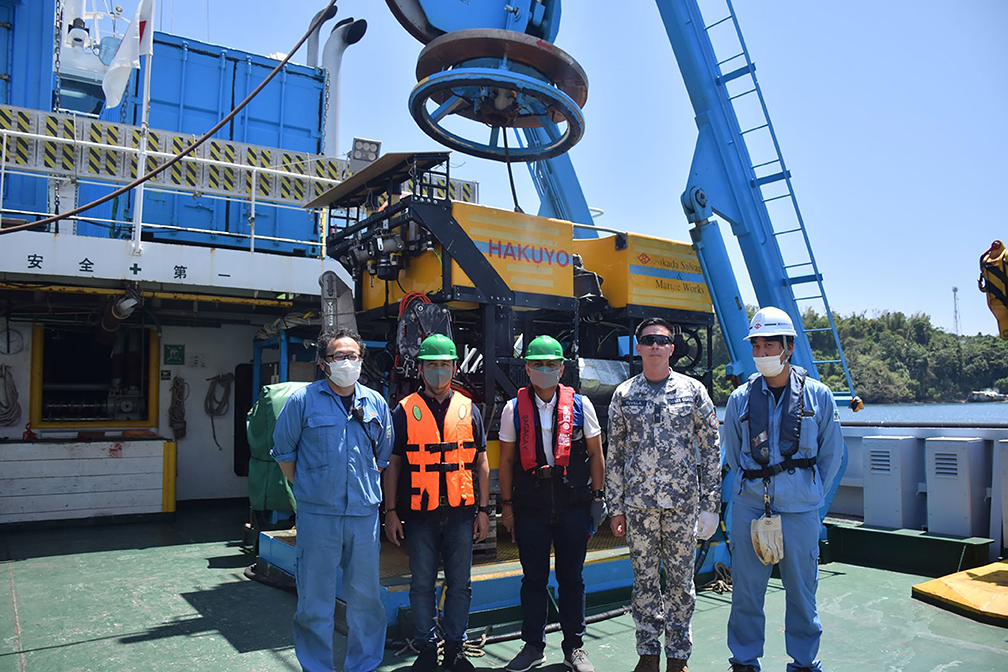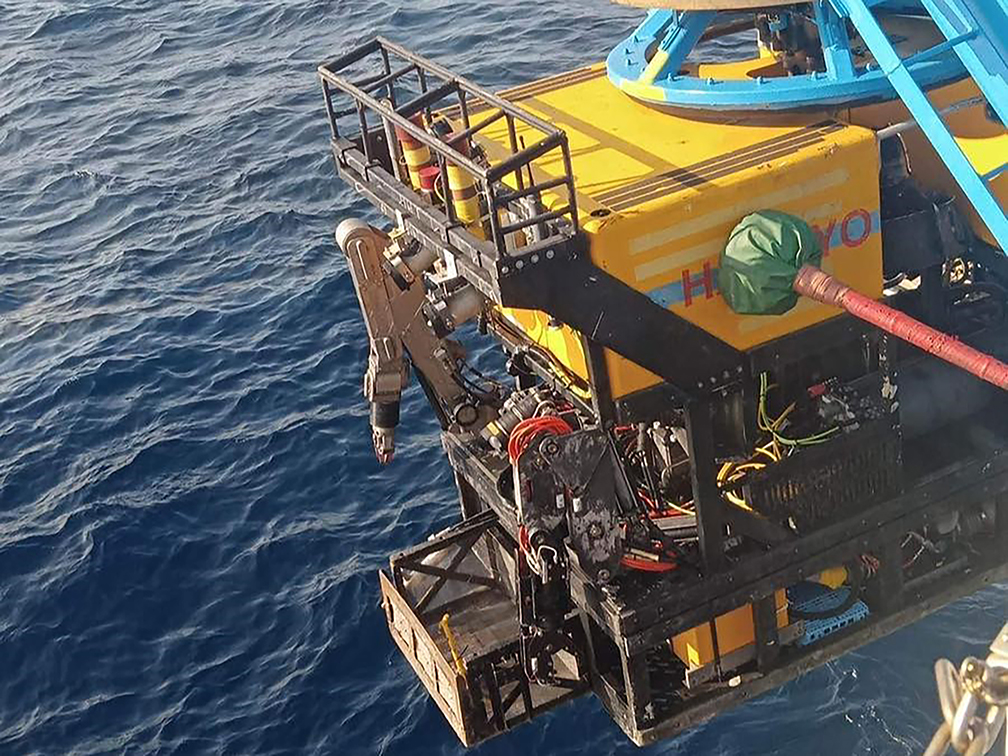WHILE locating the sunken wreck of MT Princess Empress has proven quite easy with the assistance from the Japanese dynamic positioning vessel, Shin Nichi Marui and its remotely-operated vehicle (ROV) Hakuyo, plugging the holes where the oil has been leaking is proving to be quite an herculean task as the ill-fated oil tanker is resting at around 395 meters underwater.
This was revealed by the Philippine Coast Guard (PCG) on March 22 following the successful survey of ROV Hakuyo that took place earlier.

Shin Nichi Maru had previously arrived in Naujan, Oriental Mindoro on March 20.
The ROV assessment took place 7.7 nautical miles southwest off Balingawan Point, Naujan, Oriental Mindoro, the PCG reported.
“The tanker suffered extensive structural damage after sinking. At this point, no visible consumption fuel leak coming from the damaged vessel. Oil leaks had been observed from all eight compartments (tanks), and some through the ballast tank,” the PCG, quoting the findings of the Japanese ROV team, said.

MT Princess Empress sank after encountering major engine or mechanical problems on February 28. It was loaded with an estimated 800,000 liters of industrial fuel oil at the time of its sinking.
Oil stains were also found on some parts of the vessel.
The PCG also said that oil leaks were also seen coming from the following parts of MT Princess Empress:
a) ballast tank vents and access hatches;
b) cargo tank pressure valves (P-Vs);
c) cargo pipework on deck (including valves).
The PCG said that the ROV survey noted there were no oil leaks from the ship’s fuel and service tanks.
It added that the sunken ship’s “No. 4 Port Pressure Valve has the highest flow rate.”
“Volume of remaining oil inside the compartments cannot be estimated at this point. The oil spillage rate from the source is likewise yet to be determined,” the PCG reported.
Next plan of action
WHILE the ill-fated tanker has now been located, the PCG laid down the following plans of action as “priorities for the next operational phase.”
This includes the ship’s insurance representatives searching for a “service provider that will conduct oil patching, bagging, and removal” and “hot tapping and pumping” from the sunken wreck.
Equipment for these tasks must be designed or able to operate at depths of 395 meters and beyond.
“Coordination has been established for the deployment of a Singapore-based provider. All possibilities are being explored, including the tapping of RP (Philippine)-based firms,” the PCG added.
Aid from IOPCF in oil spill cleanup
AS this developed, the PCG has sought the assistance of the International Oil Pollution Compensation Funds (IOPCF) to boost the country’s efforts in cleaning up the oil spill off Naujan.
In a statement on March 24, the PCG said assistance from the IOPCF would speed up the acquisition of ROVs.
PCG Commandant Artemio Abu said they also sought assistance from P&I London, a group of protection and indemnity insurance companies for mutual maritime insurance representing global ship owners.
Earlier, South Korean Minister Jong Soon Chang and Third Secretary Kim Dosik met with Abu and announced the upcoming arrival of the Korean Coast Guard response team and technical experts on March 28.
South Korea has also pledged to ship 20 tons of absorbent pads, 2,000 sets of protective equipment, and a 1,000-meter spill boom by the first week of April.
US Coast Guard to help in containing oil spill
AT Camp Aguinaldo, a statement from the Department of National Defense (DND) Officer-in-Charge Senior Undersecretary Carlito Galvez Jr. on March 26 said the United States Coast Guard (USCG) and some of its air assets will arrive in the country to help in the ongoing clean up operations.
Galvez, in his report to President Ferdinand R. Marcos Jr., said they expect a contingent from the USCG to arrive soon.
“We are looking forward to the arrival of the entire US Coast Guard contingent for the additional technical support in our disaster response operations. Although, one US C-17 with equipment had already arrived this morning (March 26) and is now at Subic Air Base. Another C-5 is expected to arrive,” he added.
Galvez, who is also chairman of the National Disaster Risk Reduction and Management Council (NDRRMC), along with the Office of Civil Defense (OCD) Undersecretary Ariel Nepomuceno and Abu and other military and local government officials, conducted an aerial inspection of the affected areas of the oil spill on March 26.
“We will immediately employ these assets and integrate [these] in our response operations. In addition, we continue to closely monitor the ROV’s operations for significant updates and to further determine the extent of the oil spill,” he added.
Galvez also noted that the presence of the US National Oceanic and Atmospheric Administration (NOAA) has greatly helped in the cleanup operations by providing rapid environmental assessments of the affected areas, identification of priority areas at risk of environmental damage, and assessment of the needs for ecosystem restoration.
“They (NOAA) provide support for scientific modeling to estimate the trajectory of the oil spill and satellite imagery to boost assessment efforts,” the DND chief said.
Galvez also noted that the situation in the areas in Mimaropa (Mindoro, Marinduque, Romblon, Palawan) and Western Visayas regions affected by the oil spill “is a lot better and very encouraging than I imagined.”
“Our response efforts, particularly the actions of the various government agencies, are present and very effective with the collaboration of all stakeholders, not to mention the assistance of our allies and other partner countries,” the DND chief noted.
US contracted ship
MEANWHILE, the Office of Civil Defense (OCD) announced that a US-contracted ship, anchor handling vessel Pacific Valkyrie, had arrived at Subic Bay, Zambales last March 28 and will proceed shortly to Oriental Mindoro to help in the ongoing oil spill management operations.
The Pacific Valkyrie is equipped with a submersible ROV that can conduct a video and sonar survey of the sunken MT Princess Empress, it said.
“The ROV can take still photographs, and carry a payload of 150 lb. It has function manipulators capable of work at depth and auxiliary servos for hydraulic tool operations. It also has a salvage basket that can bear 4,000 lb. The wreck survey will provide additional situational data on the shipwreck, which will assist in determining solutions to salvage the vessel and its content,” the OCD said.
Galvez thanked the US government for this assistance, which is expected to boost the Philippines’s efforts to control and resolve the environmental emergency.
“Once all mandatory checks and preparations are completed, the Pacific Valkyrie, carrying an ROV team from the US, will head to Oriental Mindoro to check the current situation of the shipwreck and its fuel cargo. We will then use data gathered to determine the next appropriate course of action to control the oil leakage coming from its source,” he added.
Aside from the ROV, the US government is also sending 11,000 feet of 26-inch absorbent harbor boom.
These containment booms will be used to control the spread of oil and allow easy recovery.
Personal protective equipment, other support equipment like vehicles, and vessels, as well as experts from the USCG, NOAA and US Navy will also be deployed to assist the effort.
Help from other allies
EARLIER, Galvez said the government would seek the help of the country’s allies and partners to mitigate the adverse effects of the oil spill.
This includes expertise and technical support of other allies and partners, such as France and the United Kingdom, he added.
“The DND, through the NDRRMC (National Disaster Risk and Reduction Management Council), and the local government units (LGUs) in Oriental Mindoro, have stepped up the government’s efforts to immediately address the effects of the oil spill from the sunken MT Princess Empress,” Galvez said.
He also pointed out that a US humanitarian assistance and disaster response (HADR) team is now on its way.
“The PCG, on the other hand, specifically requested the US for oil spill booms. Pending the approval of the President to accept the equipment, these booms will help contain the oil spill in order to protect the environment and assist in recovery,” Galvez said.

